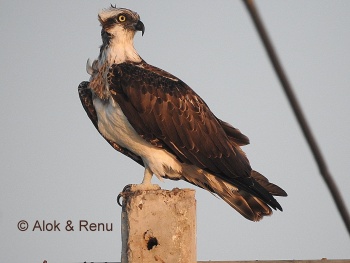Aloktewari (talk | contribs) (Image of Nominate subspecies in winter range) |
Aloktewari (talk | contribs) (Legend image 1) |
||
| Line 1: | Line 1: | ||
| − | [[Image:Osprey.jpg|thumb|550px|right|Photo by {{user|richard+bledsoe|richard bledsoe}}<br />Lake Murray, La Mesa, [[California]], [[USA]]]] | + | [[Image:Osprey.jpg|thumb|550px|right|Subspecies ''P. h. carolinensis''<br />Photo by {{user|richard+bledsoe|richard bledsoe}}<br />Lake Murray, La Mesa, [[California]], [[USA]]]] |
;[[: Category:Pandion|Pandion]] haliaetus | ;[[: Category:Pandion|Pandion]] haliaetus | ||
==Identification== | ==Identification== | ||
Revision as of 07:32, 11 December 2017
- Pandion haliaetus
Identification
A medium-large eagle-like raptor, length 55-58 cm (21¾-22¾ in), wingspan 145-170 cm, weight ♂ 1.1-1.7 kg, ♀ 1.4-2.0 kg (nominate P. h. haliaetus)
- Long, slender wings
- Dark brown above
- White with patterning below
- Rather prominant nape crest
- Dark eye-stripe
- Beak is dark
- Eyes yellow
- Talons sharp, with spine-like scales on toes for holding slippery prey.

Photo by Alok Tewari
Dist. Jamnagar, Coastal Gujarat, India, January-2016
Distribution
North America, Central America, South America, Africa, Eurasia and Australasia. Except for breeding in Australasia, this species breeds in the northern hemisphere and migrates south in winter. See Subspecies, below, for detail.
Taxonomy
Subspecies
Four[1] to six subspecies are recognised.
- P. h. haliaetus breeds in the Palearctic
- A widespread breeding summer visitor to much of Scandinavia and Russia, Belarus and Ukraine. Smaller isolated pockets of range in Scotland, Germany, Poland and the Baltic States. There are also small resident populations further south on the Atlantic coast of southern Portugal, on the Mediterranean coast of Spain, the Balearics and on Corsica. Increasing in Scotland since its recolonisation in the 1950s and now breeding in the south, and the first breeding in England for centuries has taken place. One pair bred in Cumbria in 2001 and a reintroduction scheme using birds translocated from Scotland led to successful breeding at Rutland Water. Also in 2002 nest-building occurred for the first time in the Netherlands.
- Occurs as a widespread migrant throughout Europe with peak passage periods in April-May and August-September. Migrants do not concentrate at particular sites to cross seas as many other raptors do. Most winter in sub-saharan Africa but some in the western Mediterranean, in particular on Sardinia, Sicily and North-West Africa, also at the head of the Red Sea and in southern Iraq. Vagrants recorded north to Ireland, Iceland and Faroes, also on the Azores and Madeira. A widespread breeder across northern Asia from the Urals east to Kamchatka, Sakhlain and Japan. Also breeds in the Middle East mainly on islands in the Red Sea and Persian Gulf.
- A widepread and common winter visitor to Africa from the Palearctic, most numerous in West Africa but also occurs east to Somalia and south to the Cape. Breeding range in Africa is restricted the Mediterranean coast of Morocco and western Algeria and the Red Sea and has bred on rare occasions in southern Africa. However, it does breed on the Canary Islands and Cape Verde Islands in the Atlantic. Asian birds winter in in India and southeast Asia from southern China, Taiwan, Hainan and the Philippines south to Sumatra and Borneo.
- P. h. carolinensis with paler breast-band in North America
- Breeds from western Alaska and across much of non-Arctic Canada, and in the USA over much of the north-west as far as southern California. In the east breeds around the Great Lakes, on the east coast south to Florida and west along the Gulf Coast to Mississippi. Also breeds coastally in Mexico in Baja California, Sonora, Sinaloa. A summer visitor which winters from Mexico, the West Indies and in South America south to central Chile in the west and Uruguay in the east.
- P. h. ridgwayi in the Caribbean with whiter head and breast
- P. h. cristatus (syn. P. h. leucocephalus ) from Indonesia and Australasia; treated as a separate species P. cristatus by some authorities
- Australasian breeders are resident and occur from Sulawesi and the Lesser Sundas to New Guinea, the Bismarck Archipelago, Solomon Islands and New Caledonia. In Australia breeds on much of the western and northern coasts and in the east on the coral islands of the Great Barrier Reef. Now rare on the south coast but still breeds in the Spencer Gulf and Adelaide areas.
- Birds from the Philippines to northern Australia are sometimes separated as P. h. melvillensis and those from New Caledonia as P. h. microhaliaetus but these races are usually included in P. h. cristatus.
The main subspecies have in the past been seen as full species, and there are some DNA data that support that view. The most widely followed split is between Australasian birds (as P. cristatus) and the rest; names that have been used for the split species are Eastern Osprey for P. cristatus, and Western Osprey for the rest[1].
Habitat
Closely tied to water at all seasons.
Behaviour
Among the characteristic behaviors, the one where it hovers over for example a clearwater lake and then splashes in so that the entire bird seems to disappear may be the most spectacular. Quite often, it will come up again carrying a fish, its main food.
Vocalisation
<flashmp3>Pandion haliaetus (song).mp3</flashmp3>
Listen in an external program
References
- Clements, J. F., T. S. Schulenberg, M. J. Iliff, D. Roberson, T. A. Fredericks, B. L. Sullivan, and C. L. Wood. 2017. The eBird/Clements checklist of birds of the world: v2017, with updates to August 2017. Downloaded from http://www.birds.cornell.edu/clementschecklist/download/
- Birdforum discussion thread on Osprey Taxonomy
Recommended Citation
- BirdForum Opus contributors. (2024) Osprey. In: BirdForum, the forum for wild birds and birding. Retrieved 19 April 2024 from https://www.birdforum.net/opus/Osprey
External Links





